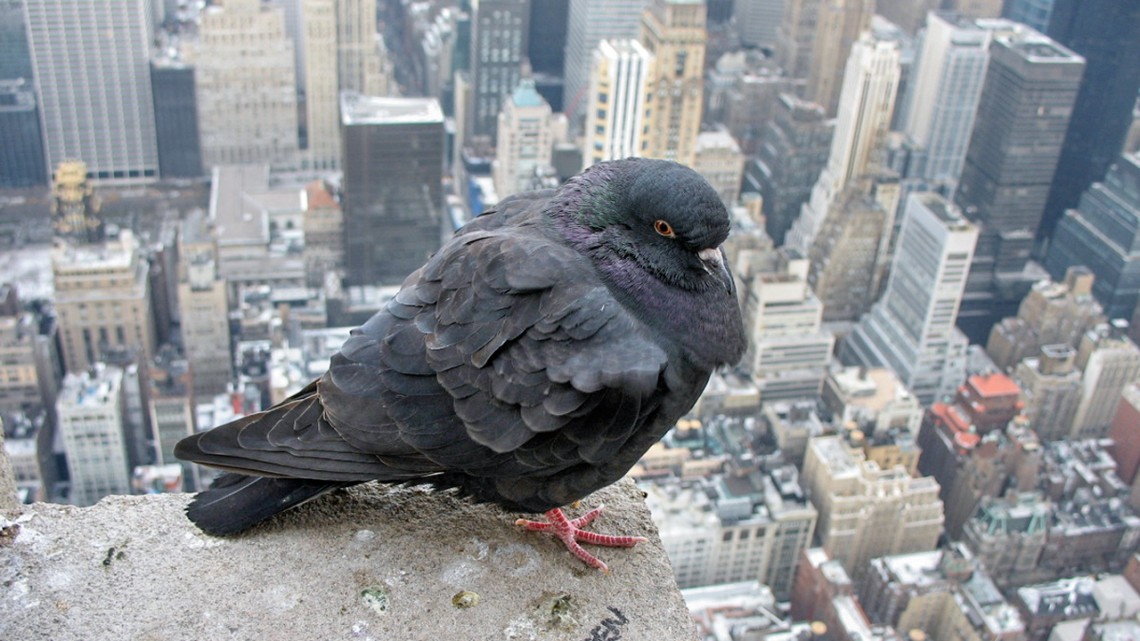
A Rock Pigeon perches on a building overlooking the city.
Cities have a role to play in bird conservation
By Kathi Borgmann
Cities provide important connections to nature as well as habitat for many species, according to new research in Frontiers in Ecology and the Environment.
Many people tend to think of cities as places devoid of nature, but a study by researchers at the Cornell Lab of Ornithology, Auburn University and Rutgers University suggests that cities offer unique opportunities for wildlife conservation, not to mention the value that nature can have for human health and well-being.
“As a city kid growing up during the 1980s, I was fascinated with peregrine falcons that nested on high-rise buildings, and that experience is what sparked my interest in birds and nature,” said co-author Frank La Sorte, a researcher at the Lab of Ornithology. “Observing birds in cities gives us an opportunity to see nature as something that is part of our well-being and if we protect nature, in the end we are protecting ourselves.”
To document the value of cities to the bird themselves, the team combined bird observations made by citizen scientists to the Lab’s eBird program; federal and state lists of threatened and endangered bird species in the United States; critical habitat designations for threatened and endangered species in the U.S.; and 2010 U.S. Census data.
In the continental U.S., 38 bird species have been listed as threatened or endangered under the Endangered Species Act. Seven of those species can be found in 81% of urbanized areas (390 out of 481) that have populations of more than 50,000. For the 618 bird species listed as threatened or endangered at the state level, 11% of them occur in urban areas in the states where they are listed.
In some cases, natural areas within cities could mean increased access to resources, warmer temperatures or protection from natural disasters, all of which could benefit some species. The authors also suggest that natural areas in cities could provide important refugia, or allow for unique reintroduction opportunities for species where reintroduction is not possible in their natural habitat.
The authors caution that cities don’t always operate as safe spaces for wildlife. A particular city would need to have positive effects on the species for at least one part of their life cycle.
“If a species is drawn to a city, but doesn’t fare well, that can be a problem,” La Sorte said.
When species are attracted to areas where they do poorly, scientists call that an “ecological trap.” Ensuring that cities are not ecological traps, through measures such as Lights Out programs and greenspace initiatives, is an important part of making a city a truly safe space for wildlife.
“If you want to understand what’s happening with bird populations, you need data across the entire landscape,” La Sorte said. “Rock pigeons, for example, are not well represented in eBird data because we don’t get many checklists from core urban areas, but that kind of information is valuable.”
Reframing our views of cities as places where we can connect with nature, the authors said, is a key to stemming biodiversity loss. Many cities are creating more opportunities for people to engage with nature, which may lead to greater environmental stewardship. Citizen science programs such as eBird, they said, have the potential to transform this engagement into real opportunities for advancing science and conservation.
Kathi Borgmann is communications project coordinator at the Cornell Lab of Ornithology.
Media Contact
Adam Allington
Get Cornell news delivered right to your inbox.
Subscribe
